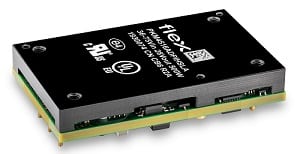- The DC-DC converter solutions from Flex Power Modules overcome the challenge of creating high-efficiency RFPAs to reduce design cycles and achieve faster time-to-market
- With 5G data to increase in the coming years, the solution facilitates power saving
 Countries and network operators around the world are introducing 5G services, thus creating a huge demand to improve the efficiency of Radio Frequency Power Amplifiers (RFPAs). According to the Institute of Electrical and Electronics Engineers (IEEE), existing LTE (4G) RFPA solutions are not suitable for operation in the 5G range due to frequency incompatibility and cannot achieve high efficiency.
Countries and network operators around the world are introducing 5G services, thus creating a huge demand to improve the efficiency of Radio Frequency Power Amplifiers (RFPAs). According to the Institute of Electrical and Electronics Engineers (IEEE), existing LTE (4G) RFPA solutions are not suitable for operation in the 5G range due to frequency incompatibility and cannot achieve high efficiency.
To overcome the challenges of creating RFPAs that can balance higher power with greater efficiency, designers can exploit the benefits of DC-DC conversion technologies. The latest DC-DC converter solutions from Flex Power Modules (in standard quarter-brick format) aims to achieve significant advances in RFPA efficiencies, helping to boost the overall energy performance of base stations. These latest DC-DC converters support key system factors such as density, integration, reliability and efficiency, enabling a growing number of RFPA developers to reduce design cycles and achieve faster time-to-market.
Flex’s recent additions to its PKM-D series of fully regulated analogue DC-DC converters, namely the PKM4516AD (28 V) and PKM4516HD (50 V) offer an output of up to 18A/504W and 10A/500W respectively. Both also deliver high efficiency: 95.5 per cent at 28Vout half load with the PKM4516AD and 95.1 per cent at 50Vout half-load using the PKM4516HD.
Supports power saving
Along with providing high Mean Time Between Failures (MTBF) of just under 8 million hours, another key feature is the output voltage adjust function of up to +20 per cent/-50 per cent, which makes it possible to power a wide range of power transistors, and support linearity and efficiency optimisation.
Power-saving factors are important. It is estimated that 5G data rates could reach 107 exabytes (EB) per month by 2023. Around 5kWh is currently required to support every GB of internet data, so 5G power consumption will need to reduce significantly if it wants to be environmentally sustainable and economically viable. To help in this regard, designers of power-demanding RFPAs are increasingly moving from LDMOS to gallium nitride (GaN) transistors, initially at base station level, due to their inherent high breakdown voltage, high power density, large bandwidth and higher efficiency.
Delivering for high power RFPA applications
Another solution from Flex Power Modules is the PKJ4000 series of DC-DC converters in half-brick format, which target even higher power RFPA applications. This series delivers 28 or 50VDC at up to 700W of power from an input voltage range of 36 to 75V. Additionally, the eighth brick PKB-D series is proving popular as a supporting product since 5V is often needed in varying power levels alongside the 50V (mostly for GaN) or 30V (mostly for LDMOS).
“Demand for our DC-DC converter solutions is growing among the major wireless telecoms companies and also with those entering the 5G arena via the OpenRAN initiative, which is looking to create open, intelligent, virtualized and fully interoperable RAN that help accelerates 5G development,” states James Zhang, Head of Sales APAC at Flex Power Modules.
Flex Power Modules has new products solutions in development, such as a soon-to-be-announced range of digital isolated DC-DC converters for RFPAs that will extend the benefits to include monitoring, configuration and control through the PMBus open protocol.






